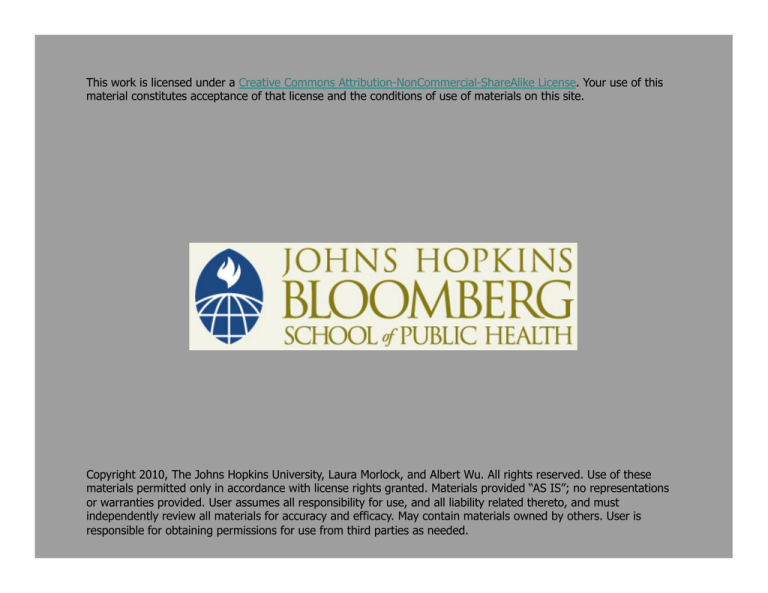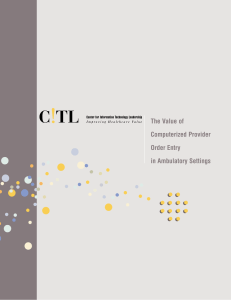
This work is licensed under a Creative Commons Attribution-NonCommercial-ShareAlike License. Your use of this
material constitutes acceptance of that license and the conditions of use of materials on this site.
Copyright 2010, The Johns Hopkins University, Laura Morlock, and Albert Wu. All rights reserved. Use of these
materials permitted only in accordance with license rights granted. Materials provided “AS IS”; no representations
or warranties provided. User assumes all responsibility for use, and all liability related thereto, and must
independently review all materials for accuracy and efficacy. May contain materials owned by others. User is
responsible for obtaining permissions for use from third parties as needed.
Adverse Events in the Outpatient Setting
Laura Morlock, PhD
Albert Wu, MD, MPH
Johns Hopkins University
Little Research on AEs Outside Hospital Settings
“Little if any research has focused on errors or adverse
events occurring outside of hospital settings, for
example, in ambulatory care clinics, surgicenters, office
practices, home health, or care administered by
patients, their families, and friends at home.”
— IOM. (1999). To Err Is Human.
3
The Outpatient Center
Most care in ambulatory settings
More and more procedures in non-hospital settings
Less and less consistently regulated
4
Outpatient Surgery
400,000 in 1984, 3 million in 2000
More than half of all surgery
Technological advances
- Laparoscopy, minimally invasive
Costs lower
- For providers
- For patients (no facility fees)
5
Cosmetic Surgery
Majority of liposuction by non-plastic surgeons
Tumescent liposuction under general anesthesia with SC
injection of diluted lidocaine + epi
Complications and deaths related to high doses, anesthesia
6
Sources of Risk
Caregivers
- Relative isolation
- Lack of peer review
- Insufficient training/experience
Team
- May not include anesthesiologist
Facilities
- Inadequate equipment, supplies, especially in crisis
- Equipment maintenance
Less regulation and reporting, fewer standards
7
New Jersey
Accreditation of facilities
Standards for monitoring, use of technology, and equipment
purchase and maintenance
General anesthesia only by anesthesiologist admitting to
nearby hospital or supervised nurse anesthetist
Mandatory reporting
8
Nature of Outpatient AEs
One year voluntary reporting (N = 100 incidents)
- Medication 47%
- Lab or X-rays 22%
- Office administration 21%
- Communication processes 10%
Source: Plews-Ogan. (2004). JGIM.
9
Ambulatory Chemo
Prospective cohort of one pediatric and two adult chemo
infusion units
10,112 medication orders from 1,606 patients
- 1,380 adults, 226 peds
Error rate 3% (306)
- 2% potentially harmful (82% adults, 60% peds)
- One-third of these potentially serious
- 45% intercepted by nurses, pharmacists
Source: Gandhi et al. (2005). Cancer, 104, 11, 2477–2478.
10
181 Closed Claims of Missed or Delayed Diagnoses
59% diagnostic errors (cancer 59%)
- Failure to order appropriate test
- Failure to create follow-up plan
- Failure to obtain adequate history or exam
- Incorrect interpretation of results
Contributing factors (median 3)
- Judgment, vigilance, memory
- Patient related (46%)
- Handoffs
Source: Gandhi, T. K., et al. (2006). Missed and delayed diagnoses in the ambulatory setting: a study of closed malpractice
claims. Ann Intern Med, 145, 7, 488–496.
11
Patient Survey of Adverse Drug Events (ADEs)
Prospective survey of 102 outpatients getting more than one prescription
in past month
Two hospital-based and two community-based adult primary care
practices
- 661 patients (RR 55%)
- 25% had ADEs (27 per 100 patients)
- 13% serious, 28% ameliorable, 11% preventable
Of 51 ameliorable events…
- 63% attributed to physician's failure to respond to med-related
symptoms
- 37% attributed to patient's failure to inform the physician of the
symptoms
Medication classes most frequently involved
- SSRIs, beta blockers, ACE-Is, NSAIDS 8-10%
On multivariate analysis, only the number of medications taken was
significantly associated with adverse events
Source: Gandhi. (2003). N Engl J Med.
12
Patient-Identified Causes of Outpatient ADEs
Medication non-adherence
Prescriber-patient miscommunication
Patient medication errors
Failure to read label/insert
Polypharmacy
Patient characteristics
Pharmacist-patient miscommunication
Self-medication
Source: Brown et al. (2006, September). Patient Educ Couns, 62, 3, 302–315.
13
Patient-Identified Causes of Outpatient ADEs
Medication non-adherence
Prescriber-patient miscommunication
Patient medication errors
Failure to read label/insert
Polypharmacy
Patient characteristics
Pharmacist-patient miscommunication
Self-medication
Source: Brown et al. (2006, September). Patient Educ Couns, 62, 3, 302–315.
14
Premise
A physician well trained in care of severely ill could easily
translate skills into excellent care of patients where patients
are less acutely ill and the pace slower
But—course of health different, many symptoms resolve,
prevention important, patients more proactive
Source: Wachter. (2006). Ann Intern Med.
15
Differences
Nature of errors
- Less common—medication administration errors
- More common—missed diagnoses
Economies of scale
- IT less feasible
- Scrutiny less intense
Patient-provider relationship
- Adherence very important
- Activation key
16
Preventing Medication Errors
Preventing Medication Errors
— IOM (2006)
17
Improved Provider-Patient Partnership Is Vital
Recommendation 1—specific measures should be instituted
to strengthen patients’ capacities for sound medication selfmanagement
- Patients (or family) should maintain an active list of all
medications
- Providers should take definitive action to educate patients
(or family) about the safe and effective use of medications
- Consultation on their medications should be available to
patients at key points along the medication use process
18
Improved Provider-Patient Partnership Is Vital
Consumers should be able to obtain quality information
about medications not only from their provider, but also from
the pharmacy, Internet resources, and community-based
resources
- However, current materials are inadequately designed for
consumers to read, comprehend, and act on
19
Advantages
Consistent collegial relationships among caregivers in offices
may make communication and teamwork easier
Longitudinal relationships make collaboration and patient
engagement easier
Economies of scale need to be developed for implementing
interventions to improve safety, especially in small officebased practices
20






